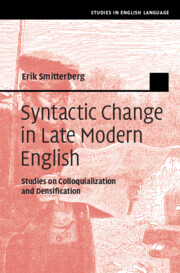Book contents
- Syntactic Change in Late Modern English
- Studies In English Language
- Syntactic Change in Late Modern English
- Copyright page
- Contents
- Figures
- Tables
- Acknowledgements
- Chapter 1 Introduction
- Chapter 2 Sociocultural and Linguistic Change in Late Modern English
- Chapter 3 Aspects of Language Change
- Chapter 4 Methodological Framework
- Chapter 5 Colloquialization I: Not-Contraction
- Chapter 6 Colloquialization II: Co-ordination by And
- Chapter 7 Densification I: Nouns as Premodifiers in Noun Phrases
- Chapter 8 Densification II: Participle Clauses as Postmodifiers in Noun Phrases
- Chapter 9 Concluding Discussion
- Appendix
- References
- Index
Chapter 5 - Colloquialization I: Not-Contraction
Published online by Cambridge University Press: 19 November 2021
- Syntactic Change in Late Modern English
- Studies In English Language
- Syntactic Change in Late Modern English
- Copyright page
- Contents
- Figures
- Tables
- Acknowledgements
- Chapter 1 Introduction
- Chapter 2 Sociocultural and Linguistic Change in Late Modern English
- Chapter 3 Aspects of Language Change
- Chapter 4 Methodological Framework
- Chapter 5 Colloquialization I: Not-Contraction
- Chapter 6 Colloquialization II: Co-ordination by And
- Chapter 7 Densification I: Nouns as Premodifiers in Noun Phrases
- Chapter 8 Densification II: Participle Clauses as Postmodifiers in Noun Phrases
- Chapter 9 Concluding Discussion
- Appendix
- References
- Index
Summary
The occurrence of not-contraction (e.g. she isn’t) in three genres in CONCE is examined in detail. In an overall quantitative analysis, not-contraction is compared with uncontracted forms as well as operator contraction (e.g. she’s not). Other potential factors accounted for include the operator itself, gender, word order (e.g. is she not vs. is not she), and no-negation as an alternative negating strategy. A multifactorial, variationist analysis of contexts where not-contracted and uncontracted forms are the main variants demonstrates the importance of factors such as genre and tense. The results provide solid evidence of colloquialization in Drama and Fiction, where not-contraction becomes more frequent; they also reveal that women may have used contraction less than men, which is expected considering the stigmatization of not-contraction, and that the uncontracted is not she pattern in questions may have been used as a more acceptable way of rendering spoken contractions in writing.
Keywords
- Type
- Chapter
- Information
- Syntactic Change in Late Modern EnglishStudies on Colloquialization and Densification, pp. 127 - 159Publisher: Cambridge University PressPrint publication year: 2021

